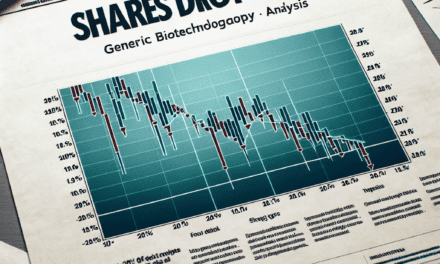“Asian Markets Surge: Riding the Wave of US Gains, Eyes Set on China’s Next Move”
Introduction
Asian markets experienced an upswing following positive momentum from U.S. stock gains, as investors closely monitored developments in China. The rally in the U.S. markets, driven by robust corporate earnings and optimistic economic data, provided a favorable backdrop for Asian equities. Market participants in Asia are particularly attentive to China’s economic indicators and policy directions, given the country’s significant influence on regional and global economic dynamics. As China navigates its economic challenges, including regulatory shifts and growth targets, its impact on market sentiment remains a focal point for investors seeking to capitalize on the interconnectedness of global financial markets.
Asian Markets Surge: Analyzing the Impact of US Economic Gains
Asian markets experienced a notable surge recently, buoyed by the positive momentum from the United States’ economic gains. This upward trend in Asian equities reflects a broader optimism that has permeated global markets, as investors respond to encouraging economic indicators from the world’s largest economy. The ripple effect of the US market’s performance has been particularly pronounced in Asia, where stock exchanges have shown resilience and growth, underscoring the interconnectedness of global financial systems.
The recent gains in US markets were driven by a combination of robust corporate earnings reports and favorable economic data, which have collectively bolstered investor confidence. As a result, Asian markets have mirrored this optimism, with key indices in countries such as Japan, South Korea, and Hong Kong posting significant gains. This positive sentiment has been further amplified by the anticipation of continued economic recovery in the post-pandemic era, as vaccination efforts and fiscal stimulus measures continue to support growth.
Moreover, the focus on China, the region’s largest economy, adds another layer of complexity to the current market dynamics. Investors are keenly observing China’s economic policies and developments, as these have far-reaching implications for the entire region. Recent data from China has shown signs of stabilization, with manufacturing and service sectors exhibiting resilience despite ongoing challenges. This has provided a degree of reassurance to investors, who are hopeful that China’s economic trajectory will remain on a positive path.
In addition to domestic factors, China’s trade relations with the United States and other major economies are also under scrutiny. The ongoing dialogue between the US and China on trade and economic issues is a critical factor that could influence market sentiment. Any progress in these discussions is likely to be viewed favorably by investors, as it could pave the way for more stable and predictable trade relations, thereby reducing uncertainty in the markets.
Furthermore, the role of central banks in shaping economic policy cannot be overlooked. In recent months, central banks across Asia have maintained accommodative monetary policies to support economic recovery. This has included measures such as low interest rates and asset purchase programs, which have provided liquidity and encouraged investment. The alignment of these policies with those of the US Federal Reserve has created a conducive environment for market growth, as investors anticipate a sustained period of economic expansion.
However, it is important to acknowledge the potential risks that could temper this optimism. Geopolitical tensions, supply chain disruptions, and inflationary pressures remain as potential headwinds that could impact market performance. Investors are therefore advised to remain vigilant and consider these factors when making investment decisions.
In conclusion, the recent rise in Asian markets, spurred by US economic gains, highlights the intricate web of global financial interdependencies. While the current outlook is positive, with China playing a pivotal role in shaping regional dynamics, market participants must remain attuned to both opportunities and challenges. As the world continues to navigate the complexities of economic recovery, the interplay between domestic policies and international relations will be crucial in determining the trajectory of Asian markets in the months ahead.
China’s Economic Influence: Key Factors Driving Asian Market Growth
Asian markets have experienced a notable upswing, buoyed by recent gains in the United States and a keen focus on China’s economic trajectory. This positive momentum underscores the intricate web of global financial interdependencies, where developments in one major economy can ripple across continents, influencing investor sentiment and market dynamics. As the world’s second-largest economy, China’s economic policies and performance are pivotal in shaping the growth prospects of its Asian neighbors, making it a focal point for investors and policymakers alike.
One of the primary factors driving Asian market growth is China’s robust trade relationships within the region. As a major trading partner for many Asian countries, China’s demand for goods and services significantly impacts their economic health. When China’s economy shows signs of strength, it often translates into increased exports for its neighbors, thereby boosting their economic performance. Conversely, any slowdown in China can lead to reduced demand for imports, which can adversely affect the economies of countries heavily reliant on trade with China. Thus, the health of China’s economy is a barometer for the broader Asian market outlook.
Moreover, China’s Belt and Road Initiative (BRI) has been instrumental in fostering economic growth across Asia. By investing in infrastructure projects throughout the region, China has not only enhanced connectivity but also stimulated economic activity in participating countries. These investments have led to improved trade routes, increased foreign direct investment, and the creation of new business opportunities, all of which contribute to the economic vitality of the region. As a result, the BRI continues to be a significant driver of growth, with its long-term benefits expected to further solidify China’s influence in the region.
In addition to trade and infrastructure, China’s monetary policy plays a crucial role in shaping Asian market dynamics. The People’s Bank of China (PBOC) frequently adjusts its monetary policy to manage economic growth and control inflation. These policy decisions can have far-reaching effects on regional markets. For instance, when the PBOC implements measures to stimulate the economy, such as lowering interest rates or injecting liquidity, it can lead to increased capital flows into neighboring countries, thereby boosting their financial markets. Conversely, tightening measures can result in capital outflows, which may pose challenges for regional economies.
Furthermore, China’s technological advancements and innovation-driven growth model have positioned it as a leader in various high-tech industries. This leadership has spurred collaboration and competition among Asian countries, driving technological progress and economic growth across the region. As Chinese companies expand their global footprint, they often bring along their supply chains, creating opportunities for businesses in other Asian countries to integrate into these networks. This interconnectedness fosters economic resilience and growth, as countries benefit from shared technological advancements and increased market access.
In conclusion, China’s economic influence is a key factor driving Asian market growth. Through its trade relationships, infrastructure investments, monetary policy, and technological leadership, China plays a central role in shaping the economic landscape of the region. As Asian markets continue to rise following gains in the United States, the focus remains on China’s economic trajectory and its implications for regional growth. Understanding these dynamics is essential for investors and policymakers seeking to navigate the complexities of the global economy and capitalize on the opportunities presented by Asia’s evolving markets.
US Market Trends: How They Shape Asian Financial Landscapes
The interconnectedness of global financial markets is a phenomenon that has become increasingly evident in recent years, with the influence of the United States’ economic performance extending far beyond its borders. This dynamic is particularly noticeable in Asian markets, which often respond to shifts in the US financial landscape. Recently, Asian markets have experienced an upswing, largely attributed to gains in the US markets. This trend underscores the significant role that US market trends play in shaping the financial landscapes across Asia.
The recent rise in Asian markets can be traced back to a series of positive developments in the United States. Strong corporate earnings reports, coupled with encouraging economic data, have bolstered investor confidence in the US. This optimism has, in turn, spilled over into Asian markets, as investors anticipate that a robust US economy will drive global growth. Moreover, the US Federal Reserve’s monetary policy decisions, particularly those related to interest rates, have a profound impact on global capital flows. When the Fed signals a stable or accommodative stance, it often leads to increased investment in emerging markets, including those in Asia.
In addition to the direct influence of US market trends, the relationship between the US and China plays a crucial role in shaping Asian financial landscapes. As the world’s two largest economies, the interactions between the US and China have far-reaching implications. Trade negotiations, tariffs, and geopolitical tensions between these two giants can create ripples across global markets. Recently, there have been signs of easing tensions, which have been welcomed by investors. The prospect of improved US-China relations has contributed to the positive sentiment in Asian markets, as stability between these two economic powerhouses is seen as beneficial for the entire region.
Furthermore, the focus on China is not solely due to its relationship with the US. China’s own economic policies and performance are pivotal in determining the direction of Asian markets. As the second-largest economy in the world, China’s growth prospects are closely monitored by investors. Recent data indicating a stabilization in China’s economic slowdown has provided a boost to market sentiment. Additionally, China’s efforts to stimulate its economy through fiscal and monetary measures have been viewed positively by investors, further contributing to the rise in Asian markets.
While the influence of US market trends on Asian financial landscapes is undeniable, it is important to recognize the unique factors within each Asian economy that also play a role. Domestic policies, political stability, and economic reforms are critical components that shape the financial outlook of individual countries. For instance, Japan’s economic policies under its new leadership, India’s structural reforms, and Southeast Asia’s burgeoning digital economy are all factors that contribute to the region’s financial dynamics.
In conclusion, the recent rise in Asian markets following gains in the US underscores the intricate web of interdependencies that define today’s global financial system. The US market trends, particularly those related to economic performance and monetary policy, have a significant impact on Asian markets. Additionally, the relationship between the US and China, along with China’s own economic trajectory, plays a crucial role in shaping the financial landscapes across Asia. As investors continue to navigate this complex environment, understanding these interconnected dynamics will be essential for making informed decisions in the ever-evolving world of global finance.
Investor Sentiment: The Role of US Gains in Asian Market Optimism
Investor sentiment plays a crucial role in shaping market dynamics, and recent developments in the United States have had a significant impact on Asian markets. Following a period of gains in the US stock market, Asian markets have experienced a notable rise, reflecting a wave of optimism among investors. This positive sentiment is largely driven by the interconnectedness of global economies and the influence of the US market on international financial landscapes. As investors in Asia closely monitor developments in the US, they are also keeping a keen eye on China, whose economic policies and growth prospects remain pivotal to the region’s financial health.
The recent gains in the US market can be attributed to several factors, including robust corporate earnings, favorable economic data, and a more accommodative stance from the Federal Reserve. These elements have collectively bolstered investor confidence, leading to increased risk appetite and a subsequent rally in stock prices. As the US market sets a positive tone, Asian investors are encouraged to follow suit, resulting in a ripple effect across major Asian indices. This phenomenon underscores the importance of the US market as a barometer for global economic health, influencing investment decisions far beyond its borders.
Moreover, the rise in Asian markets is not solely a reaction to US gains but also reflects underlying regional dynamics. In particular, China’s economic trajectory remains a focal point for investors. As the world’s second-largest economy, China’s growth prospects and policy decisions have far-reaching implications for the entire region. Recent signals from Beijing regarding potential stimulus measures and efforts to stabilize the property market have been met with cautious optimism. Investors are hopeful that these initiatives will help sustain economic growth and mitigate potential risks, thereby providing a supportive backdrop for Asian markets.
In addition to China’s domestic policies, its trade relations with the US and other major economies are also under scrutiny. Any developments in trade negotiations or shifts in geopolitical dynamics can significantly impact investor sentiment. As such, market participants are closely watching for any signs of progress or setbacks in these areas, which could either bolster or dampen the current wave of optimism.
Furthermore, the interplay between US gains and Asian market performance highlights the growing interdependence of global financial systems. In an increasingly interconnected world, economic developments in one region can have profound effects on others. This interconnectedness necessitates a more nuanced understanding of market drivers and a keen awareness of cross-border influences. Investors must remain vigilant, continuously assessing both domestic and international factors that could impact their portfolios.
In conclusion, the recent rise in Asian markets following US gains underscores the pivotal role of investor sentiment in shaping market trends. While the positive momentum from the US has undoubtedly contributed to this upswing, the outlook for Asian markets remains intricately linked to developments in China and broader global dynamics. As investors navigate this complex landscape, they must remain attuned to a myriad of factors, balancing optimism with caution. By doing so, they can better position themselves to capitalize on opportunities while mitigating potential risks, ensuring a more resilient and informed approach to investment in an ever-evolving global market.
Trade Relations: The Interplay Between US Gains and Asian Market Dynamics
Asian markets have experienced a notable upswing, buoyed by recent gains in the United States, as investors keep a watchful eye on developments in China. This interplay between US market performance and Asian market dynamics underscores the intricate web of global trade relations, where economic shifts in one region can reverberate across continents. The recent rally in US markets, driven by positive economic indicators and corporate earnings, has instilled a sense of optimism among investors worldwide. This optimism has, in turn, spilled over into Asian markets, which are often sensitive to the economic health of the United States due to the deep trade ties and investment flows between the two regions.
The United States, being the world’s largest economy, plays a pivotal role in setting the tone for global markets. When US markets perform well, it often signals robust consumer demand and economic stability, factors that are crucial for export-driven Asian economies. Consequently, Asian markets tend to react positively to US gains, as they suggest a favorable environment for trade and investment. This positive sentiment is further amplified by the interconnectedness of global supply chains, where Asian countries are key suppliers of goods and services to the US market.
However, while US gains provide a boost to Asian markets, the focus on China remains a critical factor in shaping market dynamics. As the second-largest economy in the world, China’s economic policies and growth trajectory have significant implications for the region. Investors are particularly attentive to China’s economic data, policy announcements, and geopolitical developments, as these elements can either bolster or undermine market confidence. Recent indications of China’s efforts to stimulate its economy, through measures such as monetary easing and infrastructure investment, have been met with cautious optimism by investors. These initiatives are seen as attempts to counteract the challenges posed by slowing growth and trade tensions.
Moreover, the trade relationship between the US and China continues to be a focal point for market participants. Any signs of progress or setbacks in trade negotiations between these two economic giants can have immediate and profound effects on market sentiment. A resolution to trade disputes would likely enhance investor confidence, leading to increased capital flows and economic activity in the region. Conversely, escalating tensions could dampen market enthusiasm and disrupt the delicate balance of global trade.
In addition to the US-China dynamic, other factors also play a role in shaping Asian market trends. Regional economic policies, currency fluctuations, and geopolitical developments all contribute to the complex landscape that investors must navigate. For instance, central banks in Asia are closely monitoring inflationary pressures and adjusting their monetary policies accordingly, which can influence market performance. Furthermore, geopolitical tensions, such as those in the South China Sea or the Korean Peninsula, can introduce elements of uncertainty that affect investor sentiment.
In conclusion, the rise in Asian markets following US gains highlights the intricate interplay between global trade relations and market dynamics. While US economic performance provides a crucial barometer for Asian markets, the focus on China remains paramount. As investors continue to assess the implications of US-China trade relations and regional developments, the interconnectedness of global markets underscores the importance of a nuanced understanding of the factors driving market trends. This complex web of influences requires investors to remain vigilant and adaptable in navigating the ever-evolving landscape of international trade and finance.
Economic Indicators: Tracking Asian Market Responses to US Growth
Asian markets experienced a notable upswing following gains in the United States, as investors closely monitored economic developments in China. This positive momentum in Asian markets can be attributed to a combination of factors, including the robust performance of US equities and the anticipation of economic policy shifts in China. As the global economy becomes increasingly interconnected, the ripple effects of US market movements are felt across the world, particularly in Asia, where economies are deeply intertwined with American financial trends.
The recent rise in US markets was driven by a series of encouraging economic indicators, including strong corporate earnings reports and positive employment data. These developments have bolstered investor confidence, leading to increased capital inflows into Asian markets. As a result, major indices across Asia, such as the Nikkei in Japan, the Hang Seng in Hong Kong, and the Shanghai Composite in China, have all shown upward trends. This upward trajectory is further supported by the expectation that the US Federal Reserve will maintain a cautious approach to interest rate hikes, thereby sustaining favorable conditions for global investment.
In addition to the influence of US market gains, investors are keenly observing China’s economic landscape. As the world’s second-largest economy, China’s policy decisions have significant implications for regional and global markets. Recently, there has been speculation about potential policy adjustments by the Chinese government aimed at stimulating economic growth. Such measures could include fiscal stimulus, monetary easing, or regulatory reforms designed to boost domestic consumption and investment. Consequently, market participants are closely watching for any official announcements that could signal a shift in China’s economic strategy.
Moreover, the ongoing trade dynamics between the United States and China continue to play a crucial role in shaping market sentiment. While tensions have eased somewhat in recent months, the complex relationship between these two economic powerhouses remains a focal point for investors. Any developments in trade negotiations or changes in tariff policies could have far-reaching effects on Asian markets, influencing everything from supply chain dynamics to currency valuations.
Furthermore, the broader geopolitical landscape also contributes to the current market environment. Issues such as regional security concerns, energy prices, and global supply chain disruptions are factors that investors must consider when assessing market conditions. In this context, the resilience of Asian markets in the face of external challenges underscores the region’s growing economic significance and adaptability.
As Asian markets continue to respond to US growth and developments in China, it is essential for investors to remain vigilant and informed. The interplay between these major economies highlights the importance of a comprehensive understanding of global economic indicators and their potential impact on regional markets. By staying attuned to these dynamics, investors can better navigate the complexities of the current economic landscape and make informed decisions that align with their financial objectives.
In conclusion, the recent rise in Asian markets following US gains, coupled with a keen focus on China’s economic policies, underscores the interconnectedness of the global economy. As investors navigate this intricate web of economic indicators, the ability to anticipate and respond to shifts in market sentiment will be crucial in achieving sustainable growth and stability in the region.
Future Outlook: Predicting Asian Market Trends Amid US and China Developments
Asian markets have recently experienced an upswing, buoyed by gains in the United States and a keen focus on developments in China. This positive momentum in the Asian financial landscape is largely attributed to the robust performance of US markets, which have shown resilience amid global economic uncertainties. As investors in Asia look to the future, they are closely monitoring the interplay between US economic policies and China’s evolving economic strategies, both of which are pivotal in shaping the trajectory of Asian markets.
The recent rally in US markets has instilled a sense of optimism among Asian investors. This optimism is underpinned by strong corporate earnings reports and a stable economic outlook in the United States. The Federal Reserve’s cautious approach to interest rate hikes has also played a significant role in bolstering investor confidence. As a result, Asian markets have mirrored this positive sentiment, with key indices in countries such as Japan, South Korea, and Hong Kong posting notable gains. This upward trend is indicative of the interconnectedness of global markets, where developments in one major economy can have ripple effects across continents.
However, while the influence of US market performance is undeniable, the focus on China remains equally critical for predicting future trends in Asian markets. China’s economic policies and growth prospects are of paramount importance, given its status as a major trading partner and economic powerhouse in the region. Recent data indicating a slowdown in China’s economic growth has raised concerns among investors. Nevertheless, the Chinese government’s commitment to implementing measures aimed at stabilizing the economy, such as fiscal stimulus and monetary easing, has provided some reassurance.
Moreover, the ongoing trade dynamics between the US and China continue to be a focal point for investors. Any shifts in trade policies or negotiations between these two economic giants can have significant implications for Asian markets. The potential for improved trade relations could lead to increased economic activity and investment opportunities in the region. Conversely, heightened tensions or trade barriers could pose challenges, necessitating a cautious approach from investors.
In addition to these external factors, internal developments within Asian economies also play a crucial role in shaping market trends. Structural reforms, technological advancements, and demographic shifts are among the factors that influence the long-term outlook for Asian markets. Countries that successfully navigate these changes and implement policies conducive to sustainable growth are likely to attract increased investment and drive market expansion.
Looking ahead, the future of Asian markets will likely be characterized by a delicate balance between external influences and internal dynamics. Investors will need to remain vigilant, keeping a close watch on economic indicators and policy decisions in both the US and China. Furthermore, diversification and strategic asset allocation will be essential strategies for managing risks and capitalizing on opportunities in this evolving landscape.
In conclusion, the recent rise in Asian markets, spurred by US gains and a focus on China, underscores the complex interplay of global economic forces. As investors seek to predict future trends, they must consider a multitude of factors, ranging from international trade relations to domestic economic policies. By staying informed and adaptable, investors can navigate the challenges and opportunities that lie ahead, ensuring that they are well-positioned to benefit from the dynamic nature of Asian markets.
Q&A
1. **What triggered the rise in Asian markets?**
The rise in Asian markets was triggered by gains in the US stock market.
2. **Which Asian markets experienced significant gains?**
Major markets such as Japan’s Nikkei, Hong Kong’s Hang Seng, and South Korea’s KOSPI experienced significant gains.
3. **What role did China play in the market movements?**
Investors were closely watching China for economic data and policy signals that could impact market sentiment.
4. **How did US market performance influence Asian markets?**
Positive performance in US markets often boosts investor confidence globally, leading to gains in Asian markets.
5. **What specific sectors in Asian markets saw notable increases?**
Technology and export-oriented sectors often see notable increases following US market gains.
6. **Were there any geopolitical factors affecting the markets?**
Geopolitical factors, such as US-China relations, can influence market movements, but specific impacts vary.
7. **What economic indicators from China were investors focusing on?**
Investors were focusing on indicators such as GDP growth, manufacturing output, and trade data from China.
Conclusion
Asian markets experienced an upswing following gains in the US, as investors remained optimistic about potential economic developments in China. The positive momentum in the US markets, driven by strong corporate earnings and economic data, provided a boost to investor sentiment across Asia. Market participants are closely watching China’s economic policies and potential stimulus measures, which could further influence regional growth prospects. The anticipation of supportive actions from Chinese authorities has contributed to the overall positive outlook, with investors hopeful for sustained economic recovery and stability in the region.





